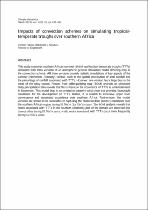 ResearchSpace
ResearchSpace
Impacts of convection schemes on simulating tropical-temperate troughs over southern Africa
JavaScript is disabled for your browser. Some features of this site may not work without it.
- ResearchSpace
- →
- Research Publications/Outputs
- →
- Journal Articles
- →
- View Item
| dc.contributor.author |
Tozuka, T

|
|
| dc.contributor.author |
Abiodun, BJ

|
|
| dc.contributor.author |
Engelbrecht, FA

|
|
| dc.date.accessioned | 2014-06-17T10:26:49Z | |
| dc.date.available | 2014-06-17T10:26:49Z | |
| dc.date.issued | 2013-03 | |
| dc.identifier.citation | Tozuka, T, Abiodun, B.J and Engelbrecht, F.A. 2013. Impacts of convection schemes on simulating tropical-temperate troughs over southern Africa. Climate Dynamics, vol. 42(1-2), pp 433-451 | en_US |
| dc.identifier.issn | 0930-7575 | |
| dc.identifier.uri | http://link.springer.com/article/10.1007%2Fs00382-013-1738-4 | |
| dc.identifier.uri | http://hdl.handle.net/10204/7456 | |
| dc.description | Copyright: 2013 Springer. This is an ABSTRACT ONLY. The definitive version is published in Climate Dynamics, vol. 42(1-2), pp 433-451 | en_US |
| dc.description.abstract | This study examines southern African summer rainfall and tropical temperate troughs (TTTs) simulated with three versions of an atmospheric general circulation model differing only in the convection scheme. All three versions provide realistic simulations of key aspects of the summer (November–February) rainfall, such as the spatial distribution of total rainfall and the percentage of rainfall associated with TTTs. However, one version has a large bias in the onset of the rainy season. Results from selforganizing map (SOM) analysis on simulated daily precipitation data reveals that this is because the occurrence of TTTs is underestimated in November. This model bias is not related to westerly wind shear that provides favorable conditions for the development of TTTs. Rather, it is related to excessive upper level convergence and associated subsidence over southern Africa. Furthermore, the model versions are shown to be successful in capturing the observed drier (wetter) conditions over the southern African region during El Nino (La Nina) years. The SOM analysis reveals that nodes associated with TTTs in the southern (northern) part of the domain are observed less (more) often during El Nino years, while nodes associated with TTTs occur more frequently during La Nina years. Also, nodes associated with dry conditions over southern Africa are more (less) frequently observed during El Nino (La Nina) years. The models tend to perform better for La Nina events, because they are more successful in representing the observed frequency of different synoptic patterns. | en_US |
| dc.language.iso | en | en_US |
| dc.publisher | Springer Verlag | en_US |
| dc.relation.ispartofseries | Workflow;12786 | |
| dc.subject | Climate models | en_US |
| dc.subject | Convection schemes | en_US |
| dc.subject | Tropical temperate troughs | en_US |
| dc.title | Impacts of convection schemes on simulating tropical-temperate troughs over southern Africa | en_US |
| dc.type | Article | en_US |
| dc.identifier.apacitation | Tozuka, T., Abiodun, B., & Engelbrecht, F. (2013). Impacts of convection schemes on simulating tropical-temperate troughs over southern Africa. http://hdl.handle.net/10204/7456 | en_ZA |
| dc.identifier.chicagocitation | Tozuka, T, BJ Abiodun, and FA Engelbrecht "Impacts of convection schemes on simulating tropical-temperate troughs over southern Africa." (2013) http://hdl.handle.net/10204/7456 | en_ZA |
| dc.identifier.vancouvercitation | Tozuka T, Abiodun B, Engelbrecht F. Impacts of convection schemes on simulating tropical-temperate troughs over southern Africa. 2013; http://hdl.handle.net/10204/7456. | en_ZA |
| dc.identifier.ris | TY - Article AU - Tozuka, T AU - Abiodun, BJ AU - Engelbrecht, FA AB - This study examines southern African summer rainfall and tropical temperate troughs (TTTs) simulated with three versions of an atmospheric general circulation model differing only in the convection scheme. All three versions provide realistic simulations of key aspects of the summer (November–February) rainfall, such as the spatial distribution of total rainfall and the percentage of rainfall associated with TTTs. However, one version has a large bias in the onset of the rainy season. Results from selforganizing map (SOM) analysis on simulated daily precipitation data reveals that this is because the occurrence of TTTs is underestimated in November. This model bias is not related to westerly wind shear that provides favorable conditions for the development of TTTs. Rather, it is related to excessive upper level convergence and associated subsidence over southern Africa. Furthermore, the model versions are shown to be successful in capturing the observed drier (wetter) conditions over the southern African region during El Nino (La Nina) years. The SOM analysis reveals that nodes associated with TTTs in the southern (northern) part of the domain are observed less (more) often during El Nino years, while nodes associated with TTTs occur more frequently during La Nina years. Also, nodes associated with dry conditions over southern Africa are more (less) frequently observed during El Nino (La Nina) years. The models tend to perform better for La Nina events, because they are more successful in representing the observed frequency of different synoptic patterns. DA - 2013-03 DB - ResearchSpace DP - CSIR KW - Climate models KW - Convection schemes KW - Tropical temperate troughs LK - https://researchspace.csir.co.za PY - 2013 SM - 0930-7575 T1 - Impacts of convection schemes on simulating tropical-temperate troughs over southern Africa TI - Impacts of convection schemes on simulating tropical-temperate troughs over southern Africa UR - http://hdl.handle.net/10204/7456 ER - | en_ZA |





